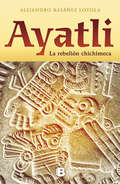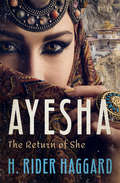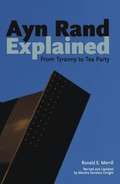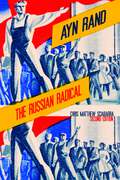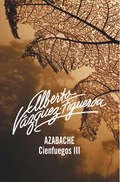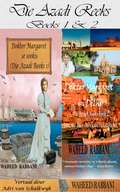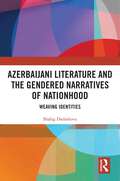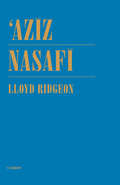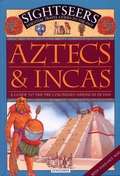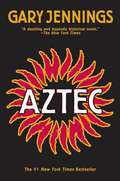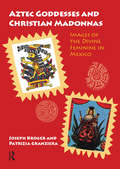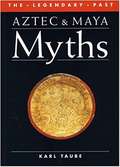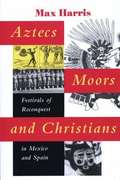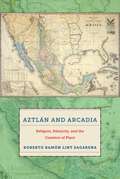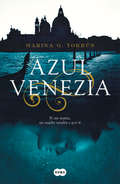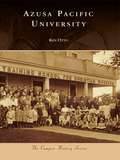- Table View
- List View
Ayatli: La rebelión Chichimeca
by Alejandro Basañez LoyolaLa esperada continuación de Tiaztlán: El fin del Imperio azteca En esta segunda entrega de La Saga de la Conquista, Basáñez nos muestra una Nueva España desgarrada por sus recientes conquistadores, quienes sedientos de poder y riqueza, a través del sistema de las encomiendas, esclavizan a los indígenas y los tratan peor que animales. Ante este terrible escenario, Ayatli, hijo del viejo Tiaztlán, decide emprender una guerra de reconquista al frente de las tribus chichimecas. Sin embargo, se encontrará con la terrible tragedia de que no sólo deberá enfrentarse a las huestes españolas comandadas por Pedro de Alvarado, sino también a las demás hordas indígenas que están dispuestas a defender a sus déspotas explotadores. ¿Ayatli logrará salir airoso ante tremenda hazaña? ¿Hasta dónde llegará la guerra emprendida por este valeroso guerrero?
Ayesha: The Return of She (Ayesha Series #2)
by H. Rider HaggardFrom the author of the long-running Allan Quatermain series: The sequel to She is a fantasy classic and one of the bestselling books of all time. In the sequel to She, Horace Holly and his ward, Leo Vincey, embark on a quest through Tibet to find the mysterious woman known as Ayesha. Though an abbot warns them not to continue, Horace and Leo press on to discover the ancient city of Kaloon, ruled by the evil Khan Rassen and his imperious wife, Khania Atene, whose desire for Leo sparks a rivalry with the volcano-dwelling Priestess of Hes . . .
Ayn Rand Explained
by Marsha Familaro Enright Ronald E. MerrillFifty-five years after Atlas Shrugged, Ayn Rand is more in the news than ever. Ayn Rand Explained is an accurate and riveting account of Rand's life, work, and influence, with the emphasis on her ideas. The book covers Rand's career, from youth in Soviet Russia to Hollywood screenwriter and then to ideological guru; her novels and other fiction writings; her work in ethics, epistemology, and metaphysics; her influence on-and personal animosity toward-both conservatism and libertarianism. Rand's Objectivism encompasses the ethics of rational egoism ('The Virtue of Selfishness'); dedication to rational thinking and acting; rejection of faith in the supernatural, personal freedom from political interference, and a moral defense of limited government and laissez-faire. Objectivism was first promoted through the Nathaniel Branden Institute, headed by Rand's young protégé and designated heir. The Institute's phenomenally rapid growth was abruptly cut short when Rand expelled Branden and his followers in 1968. Today Objectivism is represented by different factions, notably the Ayn Rand Institute and the Atlas Society. This is a revised, updated edition of The Ideas of Ayn Rand (1991), including new information on Rand's rocketing influence, new stories about her personal relationships, and new analysis of her life and ideas.
Ayn Rand: The Russian Radical
by Chris Matthew SciabarraAuthor of The Fountainhead and Atlas Shrugged, Ayn Rand (1905–1982) is one of the most widely read philosophers of the twentieth century. Yet, despite the sale of over thirty million copies of her works, there have been few serious scholarly examinations of her thought. Ayn Rand: The Russian Radical provides a comprehensive analysis of the intellectual roots and philosophy of this controversial thinker. It has been nearly twenty years since the original publication of Chris Sciabarra’s Ayn Rand: The Russian Radical. Those years have witnessed an explosive increase in Rand sightings across the social landscape: in books on philosophy, politics, and culture; in film and literature; and in contemporary American politics, from the rise of the Tea Party to recent presidential campaigns. During this time Sciabarra continued to work toward the reclamation of the dialectical method in the service of a radical libertarian politics, culminating in his book Total Freedom: Toward a Dialectical Libertarianism (Penn State, 2000). In this new edition of Ayn Rand, Chris Sciabarra adds two chapters that present in-depth analysis of the most complete transcripts to date documenting Rand’s education at Petrograd State University. A new preface places the book in the context of Sciabarra’s own research and the recent expansion of interest in Rand’s philosophy. Finally, this edition includes a postscript that answers a recent critic of Sciabarra’s historical work on Rand. Shoshana Milgram, Rand’s biographer, has tried to cast doubt on Rand’s own recollections of having studied with the famous Russian philosopher N. O. Lossky. Sciabarra shows that Milgram’s analysis fails to cast doubt on Rand’s recollections—or on Sciabarra’s historical thesis.
Ayn Rand: The Russian Radical (Re-reading The Canon Ser.)
by Chris Matthew SciabarraAuthor of The Fountainhead and Atlas Shrugged, Ayn Rand (1905–1982) is one of the most widely read philosophers of the twentieth century. Yet, despite the sale of over thirty million copies of her works, there have been few serious scholarly examinations of her thought. Ayn Rand: The Russian Radical provides a comprehensive analysis of the intellectual roots and philosophy of this controversial thinker. It has been nearly twenty years since the original publication of Chris Sciabarra’s Ayn Rand: The Russian Radical. Those years have witnessed an explosive increase in Rand sightings across the social landscape: in books on philosophy, politics, and culture; in film and literature; and in contemporary American politics, from the rise of the Tea Party to recent presidential campaigns. During this time Sciabarra continued to work toward the reclamation of the dialectical method in the service of a radical libertarian politics, culminating in his book Total Freedom: Toward a Dialectical Libertarianism (Penn State, 2000). In this new edition of Ayn Rand, Chris Sciabarra adds two chapters that present in-depth analysis of the most complete transcripts to date documenting Rand’s education at Petrograd State University. A new preface places the book in the context of Sciabarra’s own research and the recent expansion of interest in Rand’s philosophy. Finally, this edition includes a postscript that answers a recent critic of Sciabarra’s historical work on Rand. Shoshana Milgram, Rand’s biographer, has tried to cast doubt on Rand’s own recollections of having studied with the famous Russian philosopher N. O. Lossky. Sciabarra shows that Milgram’s analysis fails to cast doubt on Rand’s recollections—or on Sciabarra’s historical thesis.
Ayodhya: Archaeology After Demolition (Revised edition)
by D. MandalIt has been claimed that archaeological evidence provides irrefutable proof of the existence of a temple at the site of Ayodhya, and of the destruction of this temple by Babur.
Azabache (Cienfuegos #Volumen 3)
by Alberto Vázquez-FigueroaTercera entrega de la saga «Cienfuegos». Tercera entrega de la saga «Cienfuegos», esta novela narra las aventuras de su protagonista desde que conoce, por primera vez en su vida y para su sorpresa y estupor, a una mujer negra de carne y hueso: «¿Negra? -se asombró Cienfuegos, incapaz de aceptar lo que acababa de oir-. ¿Pretender hacerme creer que eres una mujer y además negra?». Pero, naturalmente, el canario no pone objeciones: «cada cual escoge el color de piel que más le gusta -sentencia-. Y el tuyo es el más sufrido; se ensucia menos»... En el indómito Nuevo Mundo ambos se enfrentarán a peripecias y peligros extremos, así como a una relación muy peculiar.
Azadi Reeks 1 & 2
by Waheed Rabbani Adri Van SchalkwykDokter Margaret se seekis Dokter Margaret se seekis, is Boek I van ʼn trilogie van historiese fiksie wat afspeel gedurende die stryd van Indië vir vryheid—Azadi—van die Britse Raj. Die boeke weef ʼn verhaal van internasionale intrige, konflik, en aangrypende liefde tussen interessante karakters van daardie era. In 1965 is ʼn seekis van meer as 100 jaar oud, vermoedelik dié van ʼn Amerikaanse dokter, Margaret, ontdek in die stoorkamer van ʼn hospitaal in Delhi. ʼn Ander Amerikaanse dokter, Sharif, wat oorspronklik afkomstig is uit Delhi en op kontrak is by die hospitaal, is toevertrou met die taak om die geheimsinnige vrou se familie op te spoor en die kis aan hul terug te besorg. Sharif spoor Margaret se nageslag in Grimsby, Ontario, Kanada op. Haar dagboeke en ander artefakte, soos die kroon van die Koninkryk van Jhansi, is in die kis gevind. Margaret, gebore in New Jersey uit ʼn Skotse Presbiteriaanse klerklike familie, oorwin geweldige struikelblokke en bereik haar hartsbegeerte in 1850 om een van die eerste Noord-Amerikaanse vroue dokters te word. Sy trou met haar Kanadese neef, Robert, en reis saam met hom om in die Krimoorlog van 1854 te dien. In die Krim kry hul nie net swaar met al die veldslae nie, maar moet ook ander konflikte verduur. Van gebeure wat gelei het tot en na die berugte Charge of the Light Brigade, ontmoet Margaret ʼn Russiese offisier, graaf Nicholai. Die verrassende einde van Boek I laat Margaret in ʼn verknorsing, moet sy wraak neem of moet sy voortgaan met haar reis na Indië. Op die ou end glo sy, sy het die regte besluit gemaak. ******************************************** “[Waheed] se weergawe van die Indiese Rebellie uit ʼn Indiese oogpunt is fassinerend vir die Westerse leser en behoort goed ontvang te word ...” – Ian Walker, skrywer van LOCA Dokter Margaret in Delhi is Boek 2 van Die Azadi Reeks en ‘n vervolg op, Boek 1: Dokter Margaret se Seekis. Hierdie h
Azerbaijani Literature and the Gendered Narratives of Nationhood: Weaving Identities
by Shafag DadashovaAzerbaijani Literature and the Gendered Narratives of Nationhood explores the dynamic relationship between Azerbaijani literature and the region's socio-political history. It examines how literature reflects and shapes national identity, with a focus on the gendered dimensions of this process.Analyzing literary works across different historical periods, this book reveals evolving gender roles and their portrayal in literature, highlighting the complex interaction between gender, literature, and the narratives that define gender identity. It offers a deep exploration of how women’s identities have been shaped, represented, and transformed in Azerbaijani literature from the 12th century to the post-Soviet era. Drawing on key gender theories, including the works of Judith Butler and Candace West, it examines how patriarchal structures have both restricted and enabled women’s agency across different historical periods. Through this, the volume traces the tension between tradition and modernity, highlighting how authors, as representatives of their times, perceived these tensions, interpreted them, and how they viewed the negotiation of gender roles, cultural norms, and national identity.Azerbaijani Literature and the Gendered Narratives of Nationhood is a valuable text for both students and scholars researching the history, literature and politics of Eastern Europe and Central Asia.
Aziz Nasafi
by Lloyd RidgeonShows Nasafi and his legacy in a new light. Nasafi's works are of particular interest because they contain valuable descriptions of the different Islamic world views of the age. Includes substantial extracts to help illuminate this perceptive study of a neglected figure in the pantheon of Sufi thinkers.
Aztec & Incas A Guide to The Pre-colonized Americas in 1504
by Sue NicholsonUsing a travel guide format, describes the Aztec and Inca civilizations in 1504, including their clothing, food, dwellings, sports, religion, and other aspects of daily life.
Aztec (Aztec #1)
by Gary JenningsGary Jennings's Aztec is the extraordinary story of the last and greatest native civilization of North America. Told in the words of one of the most robust and memorable characters in modern fiction, Mixtli-Dark Cloud, Aztec reveals the very depths of Aztec civilization from the peak and feather-banner splendor of the Aztec Capital of Tenochtitlan to the arrival of Hernán Cortás and his conquistadores, and their destruction of the Aztec empire. The story of Mixtli is the story of the Aztecs themselves---a compelling, epic tale of heroic dignity and a colossal civilization's rise and fall.At the Publisher's request, this title is being sold without Digital Rights Management Software (DRM) applied.
Aztec Goddesses and Christian Madonnas: Images of the Divine Feminine in Mexico
by Joseph Kroger Patrizia GranzieraThe face of the divine feminine can be found everywhere in Mexico. One of the most striking features of Mexican religious life is the prevalence of images of the Virgin Mother of God. This is partly because the divine feminine played such a prominent role in pre-Hispanic Mexican religion. Goddess images were central to the devotional life of the Aztecs, especially peasants and those living in villages outside the central city of Tenochtitlan (present day Mexico City). In these rural communities fertility and fecundity, more than war rituals and sacrificial tribute, were the main focus of cultic activity. Both Aztec goddesses and the Christian Madonnas who replaced them were associated, and sometimes identified, with nature and the environment: the earth, water, trees and other sources of creativity and vitality. This book uncovers the myths and images of 22 Aztec Goddesses and 28 Christian Madonnas of Mexico. Their rich and symbolic meaning is revealed by placing them in the context of the religious worldviews in which they appear and by situating them within the devotional life of the faithful for whom they function as powerful mediators of divine grace and terror.
Aztec Thought and Culture: A Study of the Ancient Nahuatl Mind (The Civilization of the American Indian Series #67)
by Jack Davis Miguel León-Portilla<p>For at least two millennia before the advent of the Spaniards in 1519, there was a flourishing civilization in central Mexico. During that long span of time a cultural evolution took place which saw a high development of the arts and literature, the formulation of complex religious doctrines, systems of education, and diverse political and social organization. <p>The rich documentation concerning these people, commonly called Aztecs, includes, in addition to a few codices written before the Conquest, thousands of folios in the Nahuatl or Aztec language written by natives after the Conquest. Adapting the Latin alphabet, which they had been taught by the missionary friars, to their native tongue, they recorded poems, chronicles, and traditions. <p>The fundamental concepts of ancient Mexico presented and examined in this book have been taken from more than ninety original Aztec documents. They concern the origin of the universe and of life, conjectures on the mystery of God, the possibility of comprehending things beyond the realm of experience, life after death, and the meaning of education, history, and art. The philosophy of the Nahuatl wise men, which probably stemmed from the ancient doctrines and traditions of the Teotihuacans and Toltecs, quite often reveals profound intuition and in some instances is remarkably “modern.” <p>This English edition is not a direct translation of the original Spanish, but an adaptation and rewriting of the text for the English-speaking reader.</p>
Aztec Treasure House: New And Selected Essays
by Evan ConnellHere are tales of fabulous advances made in anthropology, archaeology, astronomy, and linguistics, stories of the Anasazi, the "old ones" of the southwestern desert, of the great explorers, eccentrics, dreamers, scientists, cranks, and geniuses. "There's no end to the list, of course," Connell says, "because gradually it descends from such legendary individuals to ourselves when, as children, obsessed by that same urge, we got permission to sleep in the backyard."
Aztec Warrior, AD 1325-1521
by Adam Hook John PohlAccording to one popular image, the Aztec army was a ruthless and efficient war machine, that established an empire by convincingly overwhelming its neighbors, sacrificing thousands to bloodthirsty gods along the way. From a contrasting perspective, its native warriors were no match for the modern warring methods of Cortés' greatly outnumbered Spaniards, who decisively defeated them. The reality of the Aztec warrior's ability and effectiveness lies somewhere between those two extremes, as this title makes clear. By examining the experiences of a hypothetical individual, Cuauhtli, this meticulously researched book shows that the history of Aztec warfare is much richer and far more complex than previously understood, and reveals the close relationship between social and military matters in Aztec society.
Aztec and Maya Myths (Legendary Past)
by Karl TaubeThe myths of the Aztec and Maya derive from a shared Mesoamerican cultural tradition. This is very much a living tradition, and many of the motifs and gods mentioned in early sources are still evoked in the lore of contemporary Mexico and Guatemala. <P><P> Professor Taube discusses the different sources for Aztec and Maya myths. The Aztec empire began less than 200 years before the Spanish conquest, and our knowledge of their mythology derives primarily from native colonial documents and manuscripts commissioned by the Spanish. The Maya mythology is far older, and our knowledge of it comes mainly from native manuscripts of the Classic period, over 600 years before the Spanish conquest. <P><P> Drawing on these sources as well as nineteenth- and twentieth-century excavations and research, including the interpretation of the codices and the decipherment of Maya hieroglyphic writing, the author discusses, among other things, the Popol Vuh myths of the Maya, the flood myth of Northern Yucatan, and the Aztec creation myths.
Aztec, Inca and Maya
by Elizabeth BaquedanoUnravel the remarkable mysteries of the ancient peoples who built great palaces and pyramids, and developed an accurate calendar and a knowledge of astronomy without the benefit of telescopes or written language.
Aztec, Inca, and Maya
by Elizabeth BaquedanoChronicles the history, beliefs, and everyday lives of the ancient Aztec, Inca, and Maya peoples.
Aztecs
by Inga ClendinnenIn 1521, the city of Tenochtitlan, magnificent centre of the Aztec empire, fell to the Spaniards and their Indian allies. Inga Clendinnen's account of the Aztecs recreates the culture of that city in its last unthreatened years. It provides a vividly dramatic analysis of Aztec ceremony as performance art, binding the key experiences and concerns of social existence in the late imperial city to the mannered violence of their ritual killings.
Aztecs and Spaniards: Cortes and the Conquest of Mexico
by Albert MarrinDescribes the history and culture of the Aztec Indians in the Valley of Mexico and discusses how the arrival of the conquistador Hernando Cortes brought about the fall of their mighty empire.
Aztecs, Moors, and Christians: Festivals of Reconquest in Mexico and Spain
by Max HarrisIn this insightful book, Max Harris seeks to understand Mexicans' "puzzling and enduring passion" for festivals of moros y cristianos. He begins by tracing the performances' roots in medieval Spain and showing how they came to be superimposed on the mock battles that had been a part of pre-contact Aztec calendar rituals. Then using James Scott's distinction between "public" and "hidden transcripts," he reveals how, in the hands of folk and indigenous performers, these spectacles of conquest became prophecies of the eventual reconquest of Mexico by the defeated Aztec peoples. Even today, as lively descriptions of current festivals make plain, they remain a remarkably sophisticated vehicle for the communal expression of dissent.
Aztlán and Arcadia: Religion, Ethnicity, and the Creation of Place
by Roberto Ramón SagarenaIn the wake of the Mexican-American War, competing narratives of religious conquest and re-conquest were employed by Anglo American and ethnic Mexican Californians to make sense of their place in North America. These “invented traditions” had a profound impact on North American religious and ethnic relations, serving to bring elements of Catholic history within the Protestant fold of the UnitedStates’ national history as well as playing an integral role in the emergence of the early Chicano/a movement.Many Protestant Anglo Americans understood their settlement in the far Southwest as following in the footsteps of the colonial project begun by Catholic Spanish missionaries. In contrast, Californios—Mexican-Americans and Chicana/os—stressed deep connections to a pre-Columbian past over to their own Spanish heritage. Thus, as Anglo Americans fashioned themselves as the spiritual heirs to the Spanish frontier, many ethnic Mexicans came to see themselves as the spiritual heirs to a southwestern Aztec homeland.
Azul Venezia: Si me matas, mi madre vendrá a por ti
by Marina G. TorrúsSon jóvenes, son músicas, son hermosas y son huérfanas. Si desaparecen, nadie preguntará por ellas. O quizá sí. Una mujer independiente y decidida, con la ayuda de un oficial del ejército español, investiga unos asesinatos en serie en la Venecia del siglo XVIII. <P><P>Venecia, 1716. Caterina Sforza, aprendiz de forense e hija del médico más prestigioso de la ciudad, descubre el cuerpo de una muchacha crucificado en una góndola; está rodeado de velas encendidas y tiene los pechos teñidos de azul. Este será el primero de una serie de asesinatos con puestas en escena tan bellas como perturbadoras. <P><P>Las víctimas son alumnas del Ospedale della Pietà, el conservatorio para huérfanas con talento musical donde da clase el gran maestro Antonio Vivaldi. Caterina entrará en ese hospicio para descubrir al culpable. <P><P>No estará sola: el capitán español Alfonso Guardi, conocido en la Corte por sus dotes deductivas y su capacidad de análisis, la ayudará a averiguar qué se esconde tras las muertes en una ciudad fantasma donde nada ni nadie es lo que parece. «Una de vosotras hará algo intrascendente que la bestia interpretará como una señal del destino. <P><P>La atrapará con sus ardides, la llevará a su sala de tortura y entonces ya no habrá escapatoria...».
Azusa Pacific University
by Ken OttoLocated in the community of Azusa, 26 miles northeast of Los Angeles, Azusa Pacific University is nestled among the foothills of the San Gabriel Mountains, which provide a rugged backdrop for two campuses. The 52-acre East Campus is situated at the intersection of Alosta and Citrus Avenues, while the 22-acre West Campus is located a quarter-mile away on Foothill Boulevard. The mission statement for the university declares that it is "an evangelical Christian community of disciples and scholars who seek to advance the work of God in the world through academic excellence in liberal arts and professional programs of higher education that encourage students to develop a Christian perspective of truth and life." The university's four cornerstones are Christ, scholarship, community, and service. Throughout the history of the university, there have been several name changes and location changes; but, as illustrated in this pictorial history, the university's motto--"God First"--has remained unchanged.
